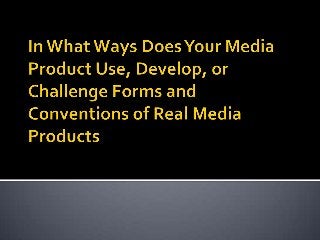
In What Ways Does Your Media Product Use, Develop, or Challenge Forms and Conventions of Real Media Products
- 2. The documentary genre is fairly broad which give great scope for creativity. There are two types interactional and observational. Out of these we chose to do a combination of the two so that we can look at the subject from a far and close up and in depth. To get to this decision we had to look at current examples of documentaries made by the distribution channel we selected ‘Channel 4’. Channel 4 tend to have unique and original print work which we sort to alienate. Also the subjects of their documentaries are normally centred people themselves.
- 3. There were a few media conventions we felt we necessary to maintain the feel of the documentary We decided to try and keep the stock characters used in many documentaries as they are , for most people, an aspect of documentaries which differentiates it from fiction The stock characters in many documentaries are: Experts A Presenter In regards to the presenter role we felt it was a necessity as it allows the audience to follow along more easily and makes it flow a lot better The expert role adds to the reliability and trusted for the audience as it adds some factual information and with terminology being used the audience is assured of the documentaries integrity. If we had changed or developed these roles I think the format may not have been as clear as we would have liked.
- 4. Another convention we felt should be maintained was the iconography so the main aspects people associate with a documentary This meant keeping the main structure of the documentary i.e. using cutaways, interviews and voice over. These aspect we found in various documentaries of all subjects in our initial research. Programmes such as ‘Planet Earth’ (BBC) and ‘My Transsexual Summer’ were especially good users of the voice over we found. In fact, the nature programmes have the best voice over, due to the fact they are not able to conduct many interviews and so the voice over is relied upon. This again added to how, generally, the text was received by viewers. We felt that careful shot selection and voice recording would create a much more professional tone to our documentary and that this would be conveyed through the iconography.
- 5. The way we developed some conventions were the way we conducted our interviews and the constructed the text around the opinions of the various people. We decided to base our documentary around the various opinions rather than using theories and looking into a single person or group of peoples views We did this so as to not show any bias towards any group and just try to give all sides of the argument
- 6. By tweaking the standard convention of using multiple experts in a field and incorporating more opinions we feel we are being fairer to more groups. No group can be offended as it is based on just opinions and everyone is entitled to their own opinion. This also allows the audience to make up their mind on their own and not be as influenced by intellectuals.
- 7. To attempt to challenge normal conventions of the documentary genre we have tried to make our target audience as broad as possible and use a topic which hasn’t really been done before. This in itself is not challenging the genre, however, we have tried to include the subject of the documentary in our demographic to try and hold a mirror up to society We felt also that if the challenges were too drastic our audience demographic of middle aged people may be put off somewhat
- 8. We decided to use a younger presenter who is part of the subject. This gives a new spin on the presentation of a groups as it is normally someone impartial and not an expert on the subject This may appeal to our demographic because it is a more modern concept, however, it is a slight gamble as it may just be too far for some people We used a young presenter as we felt it would help to challenge the current stereotype and indicate to the audience that the presenter is in the best position to understand both sides